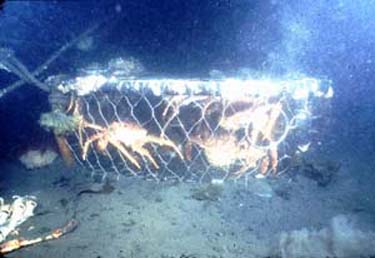
Lost Pot: Scientists say hundreds of derelict crab pots, like this one used by sport and subsistence fishermen, litter the bottom of Womens Bay on Alaska's Kodiak Island. (Photo courtesy NMFS.)
Ghost Pots
OUTRO: This is Arctic Science Journeys Radio, a production of the Alaska Sea Grant Program and the University of Alaska Fairbanks. I'm Doug Schneider.
Produced by the Alaska Sea Grant College Program and the University of Alaska Fairbanks.
INTRO: Womens Bay is a tiny ocean inlet just outside the small fishing town of Kodiak on Alaska's Kodiak Island. The bay is a favorite spot for locals to set their small, nylon-mesh crab traps—called pots—in hopes of catching an easy crab dinner. As Doug Schneider reports in this week's Arctic Science Journeys Radio, a fair number of these crab pots are lost each year, but they don't necessarily stop catching crab.
STORY: Peter Cummiskey has for several years now been studying the red king crab that live on the bottom of Womens Bay, a small inlet on Kodiak Island, about 250 miles southwest of Anchorage, Alaska. He's glued to the shells of nearly 100 crab tiny transmitters that help him follow their movements on the bottom.
And every week, he dons scuba gear to see firsthand how the crabs are doing. But all too often, he says, he finds the crabs he's labored to catch and tag and follow, are dead—having been caught in lost or abandoned crab pots.
CUMMISKEY: "We have, over the course of tagging these crab, had about a four to five percent mortality of our tagged crab within these pots. Just this past winter, on the adult crab we tagged, we had two die in derelict Dungeness pots, which are basically a pot that was fishing and the buoy got cut off by a boat prop or something."
Scientists call the problem ghost fishing. A lost crab pot set by either a commercial, personal use, or subsistence fisherman, continues to fish after the buoy that marked the pot's location becomes cut due to storms or a passing boat propeller. Cummiskey says there are hundreds of lost crab pots—mostly smaller ones used by subsistence and personal use fishermen—on the bottom of Womens Bay. Many of them are still catching—and killing—crab.
CUMMISKEY: "That pot continues to catch crab. When we went down to dive on the crab, we found a Dungeness pot that had 17 mature crab, and the other one had 19 mature crab stuck in that pot where they couldn't get out."
According to state law, all crab pots must have at least 18 inches of biodegradable mesh on a side panel so that the panel will deteriorate and allow trapped crabs to escape should the pot be lost. But Cummiskey says not everyone obeys the law.
CUMMISKEY: "From what we've seen, there's quite a number of pots that don't have that, and they continue to catch crab year after year. A lot of them are homemade and a lot of people just sort of stick them together—they don't follow the regs very closely."
Alan Jones is a wildlife enforcement officer with the Alaska State Troopers in Kodiak. One of his jobs is to enforce laws on crab pots set around the island. He says Womens Bay is a particular problem because locally bought crab pots don't meet state requirements for biodegradable mesh panels.
JONES: "I think the main problem with the personal use people is that a lot of them are new to the state. They want to do the Alaska thing and they run out and buy some crab pots and throw them in the bay, thinking they bought legal gear. That's definitely an area we have problems, but we're only talking about 15 or 20 pots that are out there at any given time."
When Cummiskey comes across a ghost pot that's still capable of catching crab, he takes steps to ensure that any crabs that happen to get caught can find an escape route.
CUMMISKEY: "That's something we do as divers. When we're down there and we see a crab pot that's still able to catch crab or fish, we disable it. We cut the webbing out. Or if it's a Dungeness pot we get the door open and mangle the door so it can't shut."
The problem isn't just in Womens Bay. An estimated 10,000 commercial crab pots—ones measuring as much as seven feet across that can hold hundreds of crabs—litter the sea floor across the Gulf of Alaska and Bering Sea.
Pots are also used to catch groundfish like Pacific cod. But Ken Hansen, a special agent with the National Marine Fisheries Service in Kodiak, doesn't think lost commercial pots kill non-target species. Agent Hansen says most fishermen are careful to keep their pot's biodegradable panels in order.
HANSEN: "I've never seen a problem in the fishery with fishermen failing to comply with these bio-panel regs. There's really no reason not to. It's in their best interest to do so, and I think they realize that. It's doesn't negatively affect the fishing at all."
Scientists don't know for sure just what the impact of ghost fishing is on the overall health of Alaska's crab stocks, but most stocks appear to be doing well. In 2000, Alaska fishermen landed 52 million pounds of crab from waters across the state.
|